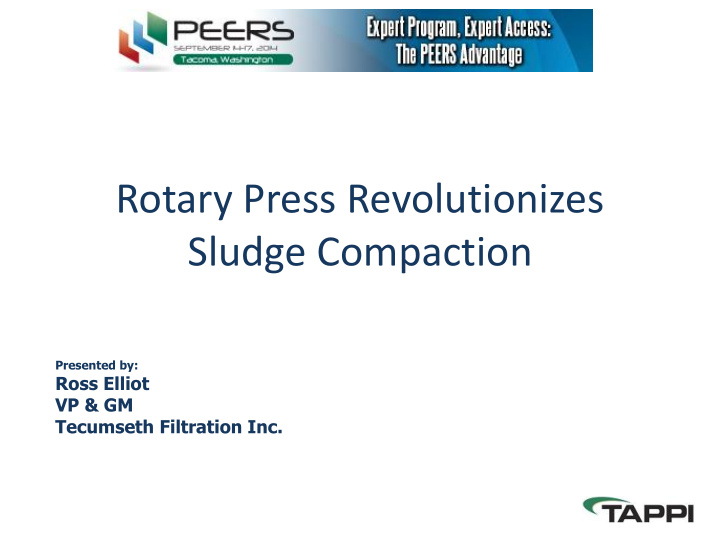



Rotary Press Revolutionizes Sludge Compaction Presented by: Ross Elliot VP & GM Tecumseth Filtration Inc.
Rotary Press Introduction • Waste sludge dewatering issues • Pulp and Paper mill sludge categories • Mechanical dewatering methods • Rotary press system design overview • Rotary press benefit analysis • Preliminary performance results • Summary
Sludge Management Issues • Final % Solids – Difference between cake and slumping sludge – Handling issue if it does not pile easily – Transport water or solids - economics • Solids Capture Rate and Filtrate Clarity • Operator Activity • Maintenance and Support • Energy Consumption • Raw Water Usage
Sludge Management Issues • Final % Solids • Solids Capture Rate and Filtrate Clarity – High capture rate versus throughput efficiency – Clear filtrate means less ‘dead - load’ in wwtp • Operator Activity • Maintenance and Support • Energy Consumption • Raw Water Usage
Sludge Management Issues • Final % Solids • Solids Capture Rate and Filtrate Clarity • Operator Activity – Manpower should focus on revenue generation – Requires equipment that accepts variable input – Equipment and area cleanup should not be required • Maintenance and Support • Energy Consumption • Raw Water Usage
Sludge Management Issues • Final % Solids • Solids Capture Rate and Filtrate Clarity • Operator Activity • Maintenance and Support – Total Cost of Ownership is a big issue – labor, parts – Rotating parts wear, belts need to be changed – Downtime expense and impact on process – Ongoing chemical usage – polymers, wash-up • Energy Consumption • Raw Water Usage
Sludge Management Issues • Final % Solids • Solids Capture Rate and Filtrate Clarity • Operator Activity • Maintenance and Support • Energy Consumption – Moving parts have drive motors, the higher the speed the greater the energy required • Raw Water Usage – Wash-up, flushing, cleanliness
Pulp and Paper Sludge Four types of WWTP residuals in P&P: • Primary sludge 40% • Secondary or waste activated 1% • Combined primary and secondary 54% • Dredged sludge 5% • Key issue is the presence of fiber
Types of Mechanical Dewatering • Typical to have a thickener prior to dewatering • Belt press – most common • Screw press – added after belt press or standalone • Centrifuge – not commonly used in pulp & paper because of fiber filtration characteristics; high speed rotation requiring large motors • Rotary press – new application
Belt Press Dewatering • Many designs and evolutions, requires pre-thickening • Stages – gravity filtration, medium pressure between belts, higher pressure between nip(s) • Susceptible to variation in feed; cleanliness issues; poor capture rate
Screw Press Dewatering • Wide variation in designs and concepts • Screw moves sludge through perforated shell or screen to thicken then dewater
Rotary Press Dewatering • Technology transfer from municipal WWT industry • Flocculation chamber followed by drainage, pressing and restriction zones
System Animation Rotary Press Animation
Rotary Press System
6-Channel Rotary Press System
Rotary Press Examples
Operating Parameter Adjustments • Inlet sludge pressure • Rotation speed of the filter • Outlet restriction pressure on bellows • Polymer dosage Impact on Performance >50% Solids • Throughput • Cake solids • Filtrate clarity >98% Capture Rate
Example Results – Breakey Fibres • Deink pulp producer – installed system trials • Sludge contains 40-50% ash
Operator Procedures Start-up • Check to ensure gap is restricted • Start filter drive, start sludge & polymer pumps • Watch until cake is produced Shutdown • Stop feed pumps • Watch until no cake is produced, stop filter drive • Knock remaining cake out with prod – cleanup done
Maintenance Requirements Change Interval(hr) Time(hr)/channel Gear box oil 4000 0.5 Scraper blades 7000 0.5 Deflector liner 7000 0.5 Shroud seals 15,000 0 Filter disks 65,000 3.5
Energy Usage • Slow rotation speed of disks (0.2 to 2 rpm) requires only small drive motors – 1-channel unit has 5 hp (3.7 KW) motor – 6-channel unit has 20 hp (15 kW) motor • Installed 6-channel unit uses about 6.65 kWh/dry ton • Polymer mixer has a 1 hp motor
Economic Benefit Summary • Energy – low operating consumption • Maintenance – reduced time &parts; fewer outages • Operations – reduced attention while in operation; reduced cleaning • Solids – higher solids reduces handling and disposal • Chemicals – lower coagulant/flocculant usage
Lab Sample Testing – OCC Linerboard
Projected Installation Results • Linerboard mill projected results from sample tests
Summary of 2014 YTD Sample Testing
Site Pilot Testing • Following sample testing, a site test is the next step • Two channel types, complete lab, sludge & polymer tanks
Rotary Press Summary • Improved technology for dewatering mill sludge • Designed for: – Low power usage – Low maintenance and upkeep – Low operator attention and support – Minimal polymer usage – Low water usage – 5 minute/day internal shower cleaning • Completely automated with alarming • Quiet, clean and odor free
Thank you! Ross Elliot ross@tecumseth.com
Recommend
More recommend